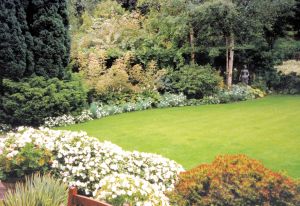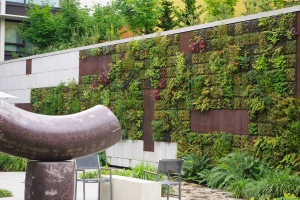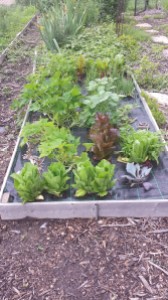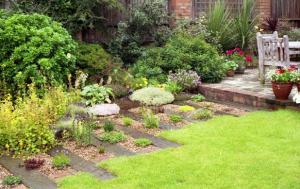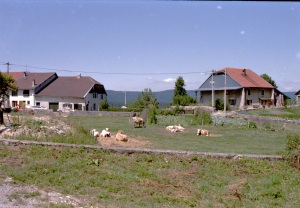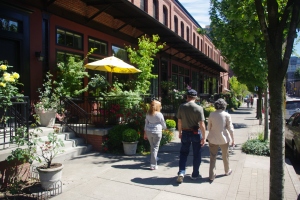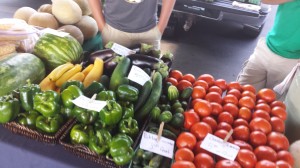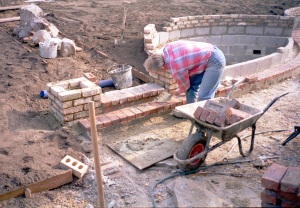-
Heaven is a Garden – Jan Johnsen
A few years ago I read a paper about how grasses ‘moved’ to music, then I read about the effects of harmonious sounds on plant growth.
Why do I mention this?
Well a few weeks ago we were talking about Tesla and his discoveries, which led us to talking about vibrations, sound waves, force fields etc., then a strange thing happened.
Ann and I interviewed a wonderful lady landscape architect Jan Johnsen, about her new book “Heaven is a Garden” we talked a little about how at a very young age she discovered during a science fair competition – which against all the odds she won – the effects early morning birds singing have on plants. The sound waves, which are similar to a violin stimulate a plant to open its stomata taking in carbon-dioxide to help it grow quicker.
Jan has written a book called Heaven is a Garden, it’s a really fascinating and informative read. Jan has ‘connected’ the dots so as to speak, between the natural world and our emotions. How the Four Winds are important when laying out a space,the careful use of curves, and my favorite Golden Rectangles and the Divine Proportion. – Phi is the mathematical proportion ( 1 : 1.618) we see in every natural form. Using this proportion ensures a sense of harmony in any outdoor space that contains it. I’ve always tried to use these proportions in my designs.
Jan then talks about Trees – natures rechargers as she puts it… The Celts shunnache, the Hindu tree devas, and Greek dryads are really references to light energy? The Chinese call this energy chi…the Japanese consider the health giving properties of trees the basis of a medical therapy called ‘ Forest bathing’, it helps reduce stress.
Jan then discusses the magnetic attraction in a Zen garden – rocks in these gardens reflect a deep understanding of the geomagnetic properties of stone and its impact on a place.
Finally the benefits of color in a garden.
You can listen to our truly fascinating interview with Jan Johnsen or if you prefer on iTunes at Growing Trends or just click on the arrow below to start the interviewWe would love to hear from you if you like this interview
Ann and Chris,
[contact-form-7 id=”781″ title=”Contact form 1″]
Podcast: Play in new window | Download
Subscribe: RSS
Views: 142
-
Eating fresh local food
Here in the USA its Spring, time to think about fresh vegetables, fruits and herbs. It’s even more important this year with the continuing drought in California where a lot of the countries fresh produce is grown as they now have a mandatory 25% reduction in water use.
If you are growing at home one of the most effective methods that has passed the passage of time is Mel Bartholomew’s – Square Foot Gardening method – Ann and I will be interviewing Mel very soon.
Before we do, Ann and I were privileged to interview Nellie, she is a young mother who is passionate about eating fresh produce on a low budget.
Our interview is inspiring for those who want to find the best way to eat fresh local food. Nellie explains how to balance your budget and yet find good healthy fresh food.
This is one very astute young lady, who is passionate about food – her mum tells me,she is also a great cook..
Podcast: Play in new window | Download
Subscribe: RSS
Views: 54
-
Country: Growing Trends -Small is beautiful in modern energy production
Ann & Chris continue their talk with Rich Sapienza and Bill Sosinsky, starting with windmills and wind turbines.
Rich is a believer in ‘Small is beautiful’ – the idea of making incremental savings of say 25% with smaller units being preferable to building huge systems that may or may not work.
Most of the savings will come as we discover more efficient energy storage and they have been exploring some interesting options.
We then move on to hydrogen power, thorium, Tesla and so much more. It’s fascinating to listen to the bright picture they paint for future generations..
Podcast: Play in new window | Download
Subscribe: RSS
Views: 69
-
Country: Growing Trends -Sustainability for the world today
Ann and Chris interview Rich Sapienza and Bill Sosinsky we talk about sustainable solutions for the world today.
It's fascinating, interesting and very enlightening.
Sustainability must work on its own, grow on its own, support itself with the built-in ability to endure and grow naturally. There must be a plan. As long as we rely on subsidies and philanthropy as the means by which we re-establish our sustainable balance on this planet, we are ultimately doomed. This lack of strategy insures we run out of sufficient monies way before we have fully addressed these essential challenges. The simple answer is that everything must work together and their needs to be a singular general vision that incorporates the best efforts of all the contributing parties
Podcast: Play in new window | Download
Subscribe: RSS
Views: 57
-
Hello world!
Growing Trends is about people, people who are passionate about their environment, their gardens & landscapes and the experts who help them.
Ann & Chris bring together interesting topics on the environment, gardening and landscaping then discuss them with fascinating people from around the world
February's & March's programs
We are concentrating on sustainability, with our second interview with Bill Sosinsky, then a fascinating series of interviews with Rich Sapienza discussing , solar power, fracking , food production, simple solutions to growing environmental issues.
We will also include some interviews with authors of some really interesting books – you can see who on our Book Review pages on www.grotrends.com
We welcome comments and suggestions… just drop us a line at info@grotrends.com
Views: 65
-
Growing Trends is listened to in 48 countries, our new program is all about people like you, from all over the world.
We would like to hear from you with ideas, comments and suggestions for our shows drop us a line at chris@chriscoope.com
We have been making changes to Growing Trends our internet based radio show, which we started back in 2015

Time to Eat – All about growing Herbs & Vegetables
Gardenesque – Everything to do with Gardens & Landscapes
World Wide Wesponsibility – A more serious look at sustainability and how we might all help our planet.
Face Time – Interviews with experts on topics of interest
Book Reviews – Interviews with authors of books relating to the environment, nature and garden landscaping.
Perhaps we could interview you for our Face Time segment? …. just drop us a line and we will contact you.
[contact-form-7 id=”781″ title=”Contact form 1″]
Views: 176
- Edibles, Food, Gardening, gardens, Healthy Living, Home & Garden, Landscape design, Landscapes & Gardens, Nature, park, Vegetable Growing
What do our kids really know about plants?
I was reading an interesting article the other day, it was discussing what today’s children know about plants.
The part that caused me to sit up and wonder was this line.. “Today’s children can identify about 1000 company logos but only identify 10 plants outside”
I wonder how accurate this statement is?
So a quick test – could you identify the plant below?
or perhaps this one.?
Thinking a little about it, brings to mind the simple realization that many children do not really understand where much of our food comes from.
We really need to change this for many reasons, perhaps our internet radio show, can help?

Listen at www.grotrends.com We want to engage ‘Granny Growers’ and introduce them to the ‘Growing Uppers’ , to start this rolling we’re heading off to interview a few senior citizens in our retirement community, to ask them what they learned and how they think we can help our grand children.
if you have some ideas , we would love to hear from you to… just drop us a line
Your message has been sent
Views: 112
-
Are you planning to add to your landscape?
Winter Time
As autumn and winter move in, with leaves changing into many hues of red and gold before falling to the ground.
The weather starts to turn chilly, the growing season is coming to an end or is it?
Some plants will head towards dormancy, others being more frost resistant will provide the last gasps of color, before winter sets in.
For the luckier ones living in warmer climates, not so much changes.

If only we could all enjoy everyday scenes like this ! Climate Change
For some others the climate has changed enough to wonder if it’s time to convert the ubiquitous lawns.
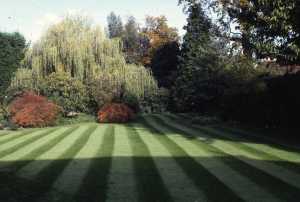
Are we going to have to change this view? Maybe into something more akin to a dessert landscape or perhaps a Mediterranean or Xeriscape landscape.

Very low maintenance, Mediterranean style Time to Plan
Now is a great time to start planning any changes as you can follow some simple guidelines.
First establish a budget. Now look at the existing and consider what you might want to change and why.
Write down a wish list of likes and dislikes, add if I could I would do this, etc,.
Design
Now it’s time to decide if you want to do the work your self?
Or find a contractor to start gathering information on materials and costs etc.
Or engage a designer who can work with you to produce a plan and a program?
Each method has it’s pros and cons. Is often decided by available budget or available time to allocate to the project.
My experience has been that most busy people are also quite successful and can therefore afford to engage a designer
They also tend to like to know what they are getting into before they start , so a design works great for them, they also like detail.

Landscape Plan Practical people can often gain most from actually working on the project themselves.
They tend to be natural problem solvers and enjoy the discovery of ‘how to achieve something’
The best advice I learned was to consider what you would like in say 5 years time, as this is often the time when any changes are going to look their best.
It is also a time to consider where you may be in your own life cycle, for example age of children, type of free time available etc.

It’s fun here… There is a “Growing Trend’ towards sustainability.
Growing one’s own food.
Now is a great time to look at all the methods available and how much time should be allocated to such endeavors.

An example from a Chelsea Flower Show exhibit Listen to ideas from experts at Growing Trends
Your message has been sent
Views: 122
- Edibles, Food, Gardening, gardens, Healthy Living, Home & Garden, Landscapes & Gardens, Nature, park, Vegetable Growing
How do you see garden landscapes evolving ?
Many years ago, we often introduced new ideas and products into our designs on a fairly regular basis. Some were because we developed our own ideas, products and subsequently ‘different’ offerings, we then ‘sold’ them to our customers.
When we started offering irrigation systems, we had to find a way to sell them to our more affluent customers, without making the costs too high, but most importantly by not disrupting or destroying the landscapes we had put in only a few years earlier.

Hydraulically installed irrigation We achieved this by finding a rather interesting hydraulic mole from Germany that used compressed air, it worked really well at a depth of 900mm and was pumped a distance of around 5m , which when reversed pulled the water pipe back through the drilled hole. This simple tool saved huge amounts of time and reinstatement costs – more importantly it amazed our clients who were thrilled that we could install such sophisticated systems without a huge amount of disruption.
Next came low voltage lighting systems, which made landscape lighting safe and easy to instal, the picture below isn’t our work it’s a Park in Paris, but it serves it’s purpose quite well.

Park in Paris Today we seem to have slowed down on major changes or have we?
Commercially vertical walled gardens are becoming quite popular and are definitely a recent development.
Whilst in Gardens we have built for over 30 years eco friendly ‘Green Retaining Walls’ such as this one

Treated Structural Green Wall Roof Gardens have been around for years, we were designing and building them back in the distant 1980’s

Wooden pathway on Roof Garden Home owners are developing a taste for their own food production.

An example from a Chelsea Flower Show exhibit Herb & Vegetable gardening is becoming very popular today.
I’m seeing a huge demand for food production, but currently the solutions are traditional cold frames, cloches or greenhouses, all very time consuming and with varying degrees of cost.
Today with all the concerns over GMO crops, with apparent excessive use of pesticides, more and more people are either buying from local organic farmers or starting out on the incredibly satisfying journey of producing their own fruit and vegetables.
We’ve been developing an easy to use kit that makes selection, planting and growing much easier and for a much longer time frame.
We call it ‘Hort Cuisine’ our way of saying it’s fun, friendly and offers tasty treats when you gather your crops.
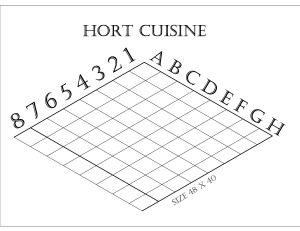
Hort Cuisine Grid The patented system enables almost limitless combinations of plants to be selected, enabling designs for any climate region.
Creating those beautiful ‘Knot’ gardens just became a simple process.
So here are a few questions……
What new ideas have you seen recently?
What would you like to see developed?
In the last 5 years what is the best landscape invention you’ve seen?
What would your customers like to add to their garden landscape?
Drop us a line with your replies we will have a follow up blog shortly.
or follow our internet radio show at www.grotrends.com
Your message has been sent
Views: 65
- Edibles, Food, Gardening, gardens, Healthy Living, Home & Garden, Landscapes & Gardens, Nature, Vegetable Growing
Where do you find inspiration….
Changing a Landscape.
Starting with an existing landscape is always a challenge..
How do you develop an idea?
Does it just grow on you?
I’ve often been asked this seemingly simple question
‘Where do you find your inspiration? ‘ or perhaps it might be
‘ Where do you get your ideas from?’ .
At first it was from seeing new things and figuring we could apply them to specific projects we were working on, albeit with a different slant, or approach. As we gained more and more knowledge ( experience) we instinctively knew what would work and what would require more thought ( more thought equates to time, experimentation and thus expense) – That’s not to say we didn’t make errors, because we surely did, luckily most times these ‘mistakes’ were of a limited nature, involving us spending more time than we expected.
I’ve always been happy to let staff experiment as long as there’s a learning process, in which they figure that making the same mistake more than once is avoidable. I’ve also found that the good old notebook and pencil is an invaluable tool, even today, writing information down has saved all manner of accidents from occurring, both financial and construction wise.
The beginnings of a well
The finished well, using bricks, oak and peg tiles.
Today our emphasis is firmly on simplifying ‘How to ‘ , in particular , with the huge changes to the worlds weather, we’ve been working hard on adapting our patented techniques so that home owners growing their own veggies & herbs in a quick ,efficiently and simply method as possible.
We are also close to enabling an 11 month growing cycle for anyone living in zones 5 and above.
Using well tried & tested, mainly low tech solutions , to achieve this.
Our “Hort Cuisine Kit” will be available soon !

Hort Cuisine Grid Using our internet radio show & this blog , has enabled us to reach hither too undreamed of audiences across the world – currently we have been listened to or read in 43 countries, so a big thank you to you all for keeping on reading.

Growing Trends a new style of garden Show on www.grotrends.com We would love to hear from you – Ann my co – host and I are hoping we can find as many ‘Granny Growers’ as possible and link them to ‘Growing Uppers’ ( our grandchildren ) , so that the knowledge, skills and techniques learned over generations of growing our own food, can be passed down before we all succumb to the mass produced, widely transported, heavily chemically sprayed, produce that has changed our once balanced diets.
Your message has been sent
Views: 45
- Edibles, Food, Gardening, gardens, Healthy Living, Home & Garden, Landscapes & Gardens, Nature, park, Vegetable Growing
How much do we really know about soil?
“We know more about the movement of celestial bodies than about the soil underfoot.” – Leonardo Da Vinci
Living a healthy lifestyle can mean many things, regular sleep, exercise, reduced stress, enjoying work, balanced eating, learning something new everyday, exploring new sights, meeting friends & relatives or a gentle stroll around a park.
Almost all involve going outside at some stage, or even spending time outside. Like this walk across the Jura Mountains in France.
When we were kids we used to dig in the ‘dirt’ , now it turns out this passed beneficial microbes to us. Plenty of microbes on the Farm.
Today we hear of parks and recreations departments that are banning pesticides and herbicides from play areas, and sports fields – 40 years ago we were more concerned with flint stones breaking the surface of the grass and ‘skinning’ kids knees when they played sports.
Field hockey needed a very even playing surface of grass to be played well, so it was often heavily compacted and over fed to keep the grass green & growing !
Research shows time and again how beneficial taking a walk in a woodland is, or sitting under a tree, or making a garden or landscape.
Yet most of us, move from one hermetically sealed air conditioned room, to our hermetically sealed air conditioned car,
to our hermetically sealed air conditioned office – is it any wonder we are losing a connection with nature?
Those folks lucky enough to live outside cities and away from the urban sprawl , are indeed fortunate.
They can leave windows open at night, refreshing the air inside, removing stale contaminated air, rarely using air conditioning.
We figured a hedge around the house and a tree canopy above was more than enough to reduce the inside temperature 20 degrees or more. It creates its own microclimate between the hedge & the house.while also providing a fair degree of privacy.
The planning process hasn’t helped much either with 140ft set backs, single story developments , individual car parking areas for each business and strip malls, that encourage you to ‘hop’ in the car to go from store to store.
Then same style sub divisions, with all vegetation ‘stripped’ , the topsoil structure almost non-existent at the construction stage, then hardly any landscaping to create interest, shade, or harmony with surrounding areas.
In fact it wouldn’t be too far to say that the effect is boring !
I wonder how many years it takes before this picture changes?
All this contributes to built in obsolescence within 25 years, the developments have very little diversity of style and worse a total lack of walking from home to the stores, – one of the healthiest pursuits for us all.
One of the major advantages of living in towns or cities is this easy connection with homes, stores, work places and amenities.
We all tend to be creatures of habit, so this routine is a hard one to alter
There are signs of a healthier approach.
Mass transit provides a wealth of benefits, less pollution, easier and quicker commuter travelling, safer travelling, an opportunity to connect with fellow citizens. A more relaxed journey.
Green walls in the urban environment soften an otherwise ‘hard’ landscape, reducing the carbon footprint of the area, making a much more ‘pleasing’ view.
Roof gardens make a more focused impact, they improve the carbon foot print, offer a new habitat and an amenity for the buildings users.
It seems all those ideas, methods and activities from yesteryear were not all that bad for us.
Our connection with nature is again expanding with more and more people exploring the option to grow their own food, or seek out farmers markets.
I suspect for this to become even more popular there will be a need to initially at least simplify the mysteries of growing your own?
The Community Garden or Allotment is a great way to learn the ‘tricks of the trade’ – these are either individual growing areas ‘Allotments’ or the more common these days communal ‘Community Garden’
Of course there is the local ‘Pick your Own’ farms for all those inseason goodies.
From ‘Farm to Table’ might be best said as from ‘Grower to Consumer’ – if this were local, it would have a huge impact on carbon emission reductions ( a lettuce travels 1400 miles to reach your table, not sure how that could ever be described as fresh!).
The more we as professionals make this process easier the greater the likely uptake by households in towns and cities, where new skills will need to be developed.
A really easy start.
A stacked group of herbs, perfect for a compact space.
or much more complex, this lovely exhibition garden shows how to create small garden boxes of produce.
Now all we need is a simple method for the consumer… It will need to have an option which includes a growing medium as many urban yards have very poor soil conditions.
This system can be found at www.picagardi.com
Using a unique patented layout grid. enabling almost anyone to place plants in the correct positions is an option.
Listen to our up coming internet radio show all about developing gardens at www.grotrends.com we call it ‘Hort Cusine’ !

Hort Cuisine Grid The very popular and effective Square Foot Gardening Foundation, developed by Mel Bartholomew has been around for many years, with countless books, examples and users.
As has the New Organic Grower & Four Season Harvest to name but a few from Eliot Coleman, an amazing grower in Maine.
It’s time to really try and add herbs & veggies into our urban landscapes.
We as landscape professionals need to promote home grown food more when we plan new landscapes for clients.
Views: 165
-
So what’s really new today in landscape work?
Looking back over a good few years, it seems to me that only a few things have changed.
Mostly the changes are in office equipment,our office wasn’t particularly fast to adapt to CAD or computerised pricing, ( which as I recall we started in earnest around 1990) we didn’t produce thousands of drawings, although with three full time designers we might have been able to complete our standard detail book quicker.
What we did have, which was invaluable, was a huge collection of standard minute values for thousands of manual site operations, gathered by a group of work study techs who followed us for years.
These values are still useful today, as I’ve found a ‘rate’ for a job is no where near what the job costs with overhead & profits or is worth in every situation.
Oddly, when you take a real look, it seems not too many on- site tools have changed very much over the years, the hammer remains the same,the pick, the saw, the rake, as does the garden fork, the trowel, the cement mixer, the plate compactor – all are virtually the same as they were years ago.
The one exception being perhaps the Dingo or it’s derivative…
This picture is a classic example, this car park in Kent was being resurfaced in 1978, the equipment although not lazer guided isn’t far removed from today’s.
Engines, drive trains, hydraulics, not that many really new tools, and a few altered methods, such as rotary grass cutting, self sealing sand, geotextile fabrics, and the use of plastics have all appeared – Some , I wonder for how long?
Is it time for a revolution in equipment ? if so, I wonder what will appear ? or has the demise of manufacturing reduced us to just accepting products that are derived from abroad ? Do you have a wish or an idea?
I suspect the humble wheel will take some beating over the next generation.
As a Landscape Design & Build professional, I’ve visited literally thousands of homes over the years, talked to the owners, sold them on design & build, managed the project , with a fantastic team who helped us win a large number awards.
As a Landscape Contractor, I’ve read, priced, won & lost , then programmed, then managed thousands of projects designed by other companies or individuals, with the team still winning a large number of awards in the process.
There have always been the same few common traits.
An agreed Design was produced, with an agreed priced Bill of Quantities.
The Designer kept in touch with the project until completion. – you can see him just in this picture below.

After working a little magic ! The Foreman, was in charge of the site ( our man on the site) stayed on the site with his team,until the project was completed.
We paid particular attention to detail, keeping the sites clean & tidy.
The client made stage payments to an agreed schedule.
We avoided extras, unless they were essential.
We under promised & over supplied. – the weather was almost always the one item we were unable to control.
We sent our aftercare folks in to show the client how to keep his newly paid for project in good order – irrespective of if we had an aftercare contract. ( Finished photographs are great for the portfolio and are easier to take if the site looks great, plus we treated every job as a potential award winner. !)

Sometimes I would call in and cut the clients grass to get away from the office. We were rarely the cheapest price available, we & the client knew this, we did have a professionally staffed office, we employed our own designers, landscape architects, contracts managers, and building staff who were all fully equipped, with all the necessary tools and machines.
We avoided heavy machinery in gardens preferring to use tracked equipment that didn’t compact the ground too heavily, we hardly ever used ‘Bobcat’s’ , but always used min-360 excavators, and tracked carriers.
The mini-tractor being the exception as it was so useful, perhaps with the advent of the dingo that’s not the case anymore ?
When we installed irrigation we preferred to use hydraulic powered horizontal augers which left almost no mess.
This system was really effective, it used an air compressor, but was able to pull the pipe back through the hole just formed, it worked great with Toro 300 series heads for example.
We preferred to work with natural materials ( like bricks, timber, natural paving cut to rectangles) to artificial ( concrete, concrete blocks, plastic, etc.,)
We always kept the conversations semi formal whilst the job progressed, not becoming too familiar was a huge benefit at times. Once the project was finished we relaxed our formal approach.
It wasn’t possible to not have misunderstandings on occasions, however we documented everything, and on the very rare moments when clients became agitated we gently showed what had been agreed and how we could adapt this to their new wishes – we always remembered that this was our job, we were the experts, but it was their project!
We often acted as Designer, Surveyor, Builder and Quality Controller for the Client, who often had scant knowledge of construction issues, so we tended to be much more, should I say tolerant in these situations.
If we were dealing with fellow professionals, then we played hard ball with the best of them !
Ann & I have started a radio show where we interview Clients, Designers, Creators, Maintainers, and the experts that help them, you can listen to a show here or even download for later – Growing Trends
If you would like to be considered for a show, do drop us a line and tell us why, we are now heard or read in 43 countries !
Ann & Chris
Your message has been sent
Views: 77

